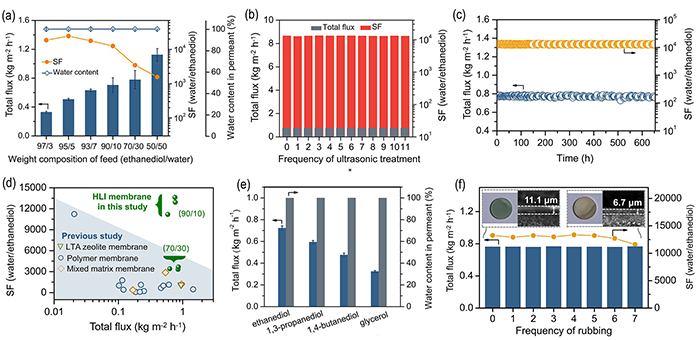Hetero-Lattice Intergrown and Robust MOF Membranes: A Potential Solution to Polyol Upgrading in Industry
Metal-organic frameworks (MOFs) bring tremendous opportunities for separation of liquid chemicals using membranes.
However, due to lack of highly compact and robust micro-architecture to cope with complicated and tough separation situations, MOF membranes available for liquid chemical upgrading through pervaporation are rare.
Recently, a research group led by Prof. YANG Weishen and Dr. BAN Yujie from the Dalian Institute of Chemical Physics (DICP) of the Chinese Academy of Sciences (CAS) proposed hetero-lattice intergrown (HLI) and robust MOF membranes for polyol upgrading in industry.
This study was published in Angew. Chem. Int. Ed. on Dec. 22, 2021, and was selected as "Hot Paper".

Pervaporation performances through the optimal HLI membranes (Image by BAN Yujie and WANG Yuecheng)
The researchers synthesized HLI membranes, with the integration of two distinct network MOFs, namely MIL-53 (Al) and amino-MIL-101 (Cr), at molecular scale.
They demonstrated that the highly compact and robust micro-architecture was contributed to the complementary growth, concomitant with the strong connection between these two lattices.
The HLI membrane with ultra-stability showed excellent pervaporation dehydration performances for C2-C4 polyol solutions. Furthermore, polymer-grade ethanediol (99.93%) through HLI membranes could be obtained, saving ca. 32% of energy consumption relative to the traditional vacuum distillation.
"These results spotlight the potential of MOF membranes to create more solutions for current separation challenges," said Prof. YANG.
This work was supported by the National Natural Science Foundation of China. (Text by BAN Yujie and WANG Yuecheng)